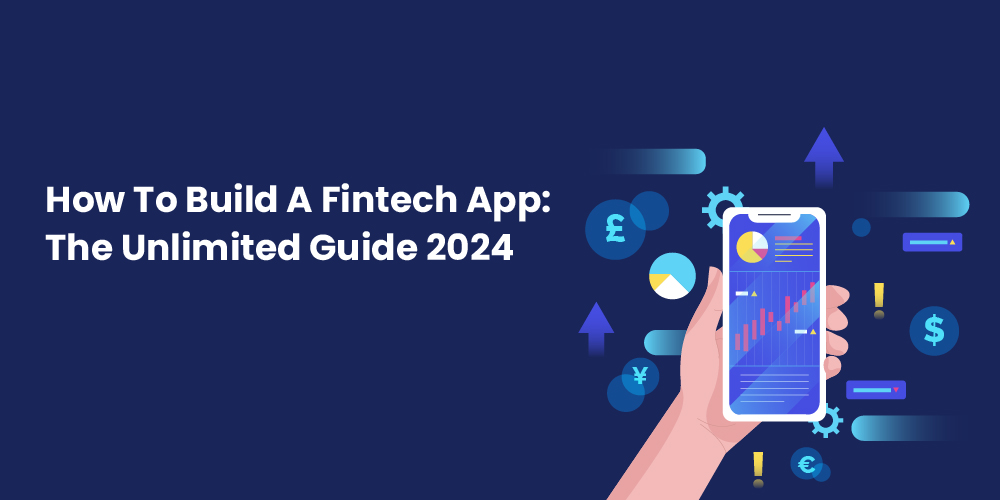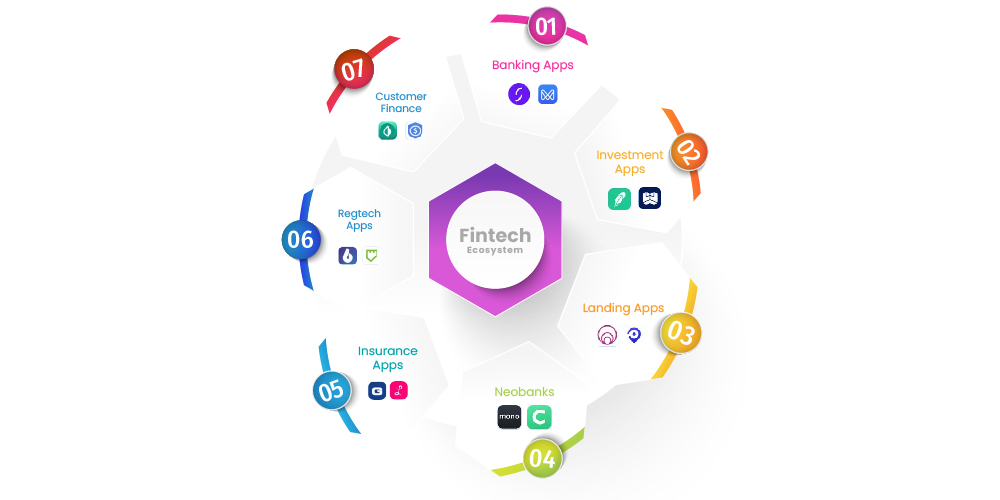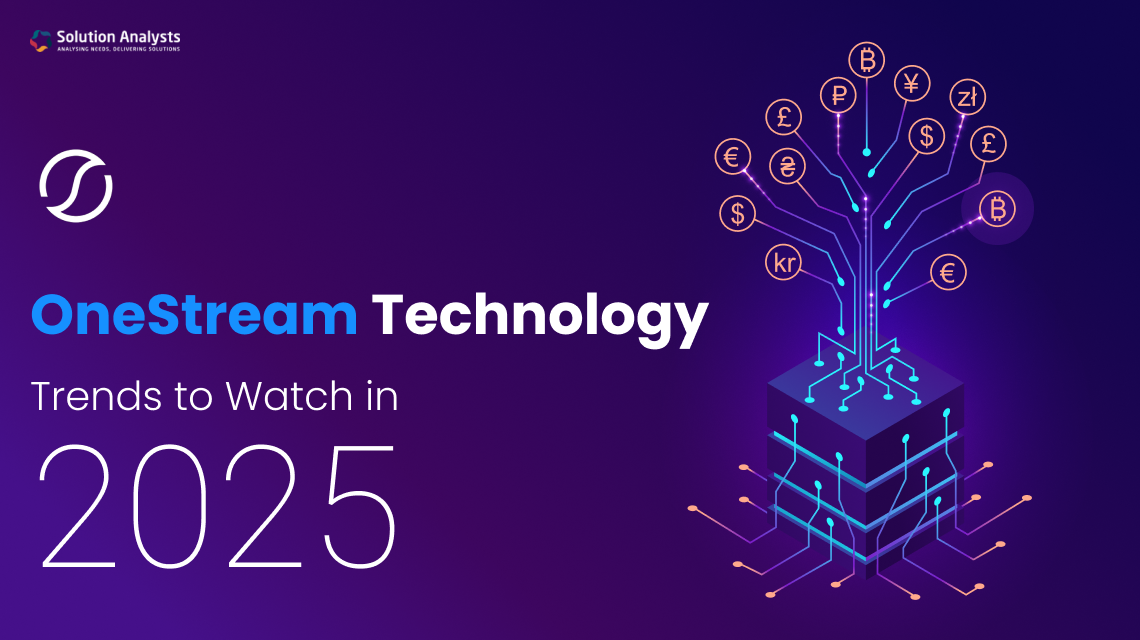
Table of Contents
With rapid evolution, fintech companies continue to redefine how individuals and businesses manage, access, and interact with financial services. Technology has helped reinvent the fintech industry to help overcome traditional challenges.
Moreover, Technologies offer innovative solutions that upgrade traditional financial services and fintech into more secure, convenient, and real-time proceedings. Presently, major tech trends that are ruling the fintech industry are AI-driven Analytics, Cloud, and Data Analytics.
Undoubtedly, the upcoming realm of financial-based tech innovations ensures to meet the financial domain, reshaping traditional financial services through digital platforms that deliver effective authentication, smart contracts, and personalized experiences.
Here we are creating a comprehensive guide that will dive deeper into the process to help you build a fintech app, focusing on the crucial steps and insights to navigate this rapidly evolving industry. Explore the strategies, methodologies, and core principles that drive the creation of groundbreaking financial technology solutions.
What is Fintech
Finance and Technology, the amalgamation of both of them is known as fintech. In the past 200 years, the modes in which we conduct transactions have evolved. The technological revolution has changed the fiat currency into digital. We can now conduct the transactions in any country of our choice, at our convenience.
The mobile phone applications market has been flooded with fintech apps. There is an app for every possible use case. Some common examples include Mobile recharges, electricity and gas bill payments, money transfers, ticketing, investments and the stock market, and calculators to know interest rates and ROI. If you wish to create a fintech app, you can conduct market research to find gaps in the market and create an application that fulfills that gap.
Growth of technology in fintech:
The Global fintech market is estimated at $194.57 billion. KPMG has reported funding in Fintech globally climbed $52.4 billion in the year 2023. According to McKinsey, in 2022 fintech accounted for $150 billion of the global banking sector revenue, which could increase up to $400 billion by 2028.

Types of Fintech Apps
These use cases span diverse functionalities, catering to the various user needs. This exploration centers on the world of how to build a fintech app, covering the applications based on offered functionalities, and the impact created.
-
Investment Apps:
Investment Apps are a cornerstone, revolutionizing the way users explore and engage with investment opportunities, manage portfolios, and enter into the financial markets. This type of application can provide a user-friendly platform that empowers both, newcomers and seasoned investors to participate in different types of investment opportunities using smartphones or computers.
Investment Apps offer:
- Accessibility and Convenience
- Monitor portfolios and track the market in real-time
- Diverse options for investment
- Portfolio Management
- Educative Information
-
Payments Apps:
Payment apps serve as pillars of convenience, revolutionizing the way transactions have been conducted, funds have been transferred and the finance has been managed. These applications offer seamless and efficient solutions, reshaping the digital economy. Payment applications offer a wide array of features designed to streamline transactions and enhance user experiences.
Payment Apps offer:
- Peer-to-Peer Transactions
- Instant money transfers
- User-friendly interfaces
- Secure transactions
- Digital payments
- QR code payments/ Near Field Communication (NFC)/ Contactless payment
- Bill payments
-
Lending Apps
Offering financial independence to individuals or businesses has always been there but providing the ease to access the capital digitally has revolutionized the financial landscape. Leveraging technological advancements, these apps have streamlined the loan application process, making it more accessible, efficient, and convenient for users.
Lending Apps Offer
- Seamless Application
- Quick Approval & Disbursement
- Transparency in transaction
- Financial education
- Diverse Loan Options
- Flexible Repayment
- Advanced Security
-
Insurance Apps
Insurance apps offer a transformative force in the insurance industry, it leverages technology to offer convenient access to insurance to policyholders. Developed with a user-centric approach Insurance apps simplify the purchase, management, and claims processes for the insurance policies.
Insurance Apps Offer
- Policy Management
- Insurance Education
- Instant Policy Quotes
- Transparency
- Claims Processing
- Risk Management
-
Financial Planning & Management Apps
Financial planning apps have emerged as powerful tools in helping people manage finances, achieve monetary goals, and secure financial futures. These apps provide a comprehensive platform that offers to track expenses, save, invest, and plan for retirement.
Financial Planning & Management Apps Offer
- Budgeting and Expense Tracking
- Goal Setting & Monitoring
- Investment Options
- Financial Education
- Personalized Financial Guidance
-
Crypto Apps
Crypto applications are based on blockchain technology that offers digital currencies. These applications offer users a gateway to enter the world of cryptocurrencies, offering access to trading, investing, storing, and managing various digital assets. The financial world has witnessed a paradigm in recent times, especially with the emergence of cryptocurrencies and blockchain technology. These innovative applications are enabling individuals worldwide to engage with various cryptocurrencies.
Crypto Apps Offer
- Cryptocurrency trading
- Crypto Wallet
- Crypto Payments
- Education regarding Crypto and Blockchain
- Secured Encryption
-
Neo Banks
Neo banks are also known as digital banks or challenger banks. Neo Banking applications represent a disruptive force in the traditional banking sector. These innovative financial institutions leverage cutting-edge technology and a customer-centric approach to redefine the banking experience for the digital-savvy generation. Unlike traditional brick-and-mortar banks, neo-banks operate exclusively in the digital method.
Neo Banks Offer
- Digital only operations
- Simple user onboarding
- Innovative financial tools
- Customer-centric approach
- Integration with other applications
- Enhanced Security
- International transactions
-
Regtech Apps
Regtech, a short for regulatory technology, represents a new wave within the financial industry. Regtech applications streamline and automate regulatory compliance processes with the help of technology. Technological solutions aimed at simplifying compliance tasks, mitigating risks, and ensuring adherence to regulatory frameworks, ultimately enhancing operational efficiency and reducing compliance costs.
Regtech Apps Offer
- Automated Compliance
- Real-Time Monitoring
- Anti-Money Laundering
- Data Governance and Privacy Compliance
- Risk Assessment
- Record Keeping
- Regulatory Education
-
Crowdfunding Apps
Providing a platform for individuals, entrepreneurs, and innovators to raise capital for their projects or to take on any unprecedented situation, crowdfunding applications can power the crowd by allowing everyone to allow and provide support. Crowdfunding apps act as intermediaries, facilitating connections between project creators seeking funding and individuals looking to invest or contribute financially to these initiatives.
Crowdfunding Apps Offer
- Diverse Funding Models
- Project Discovery
- Community Building
- Secure Payment
- Campaign Management
- Flexible Funding
- Regulatory Compliance
- Global Reach
- Educational Resources
Things to Keep in Mind Before Developing a Fintech App
Technological advancements have advanced every aspect of our lives. Fintech represents a disruptive force, reshaping traditional financial services with the help of innovative technology with the goal of enhancing accessibility, efficiency, and user experience.
Building a Fintech app has become a strategic step for businesses to change how financial services are delivered. When it comes to creating a Fintech application, It is not merely about creating another application, it’s a proactive response to target the evolving market needs, technological changes, and the behaviours of consumers. The demand for fintech apps is also boosting the IT industry’s growth all around the world. The cost to develop fintech app with a simple configuration may cost anywhere between $15,000 to $ 40,000 while integrating advanced features may raise the cost to $1,50,000 or in some cases higher than that.
The following exploration delivers the compelling reasons why investing in the creation of a Fintech app is important for businesses, entrepreneurs, and innovators.
Addressing the Market Needs
- Identifying Needs:
Identifying and addressing the market needs are very important to offer specialized services that traditional banks might have missed. - Niche Opportunity:
Identifying niche markets or specific demographics with unique financial needs can be efficiently addressed through a specialized app.
Technology Innovation
– Leveraging Cutting-Edge Technology: Developing a Fintech app allows the integration of innovative technologies like blockchain, AI, Machine Learning, or Biometrics offering novel features.
– Improving Efficiency: Automation and digitization processes reduce operational costs, and improve efficiency compared to traditional banking systems.
Enhance User Experience
Customer-Centric: Fintech apps prioritize user experience by providing personalized services, and hassle-free transactions which leads to higher user engagement and retention.
Convenience and Accessibility: Easy access to financial services anytime, anywhere via smartphones or computers offers convenience to its users.
Digital Trends
– Mobile-First: Mobile usage is continuing to soar, and developing a Fintech app can help grow with this trend and become the go-to place for financial solutions.
– Adapting to Changing Behaviors: Users increasingly prefer digital channels for financial activities. Fintech apps align with these shifting behaviors and preferences.
Disrupting Traditional Banking Models
– Disruption and Innovation: Fintech apps disrupt traditional banking models, challenging established norms, and offer alternative solutions that are more agile, and cost-effective.
– Competition: Fintech space is filled with competition with traditional banks and other Fintech players, potentially capturing a share of the market. The upcoming companies need to be disruptive and innovative to capture the market share.
Financial Inclusion and Accessibility
– Serving Underbanked Populations: Fintech apps offer financial services to underserved populations, promoting financial inclusion and empowering individuals with limited access to traditional banking services.
– Tailored Solutions: Customized services for specific demographics or regions help meet diverse financial needs., and can promote inclusion and catering to a broader audience.
Regulatory Compliance and Security
– Compliance Measures: Developing a Fintech app involves implementing robust security measures and complying with regulatory standards, ensuring user data protection and trust.
– Trust and Reliability: Ensure the creation of a secure app that meets regulatory requirements and confidence in users, leading to increased adoption and usage.
Monetization and Business Opportunities
– Revenue Streams: Fintech apps can have multiple revenue streams, including subscription models, transaction fees, partnerships, or premium service offerings.
– Partnerships and Collaborations: There are multiple ways to collaborate with other Fintech companies or established financial institutions that can provide new business opportunities and revenue channels.
Data-Driven Insights and Analytics
– Data Utilization: Fintech apps can leverage user data to get insights and analytics, enabling better decision-making, personalized services, and predictive financial guidance.
– Improving Offerings: Utilizing data analytics can help in continuously refining and enhancing the app’s features, services, and user experience based on user behaviors and preferences.
Scalability
– Future Growth Potential: Fintech apps have ample room for growth and scalability, given the dynamic nature of financial technology and the evolving needs of users.
– Staying Ahead of Trends: Continuously adapting and evolving the app can help to incorporate emerging technologies and industry trends to ensure long-term relevance.
Developing a Fintech app involves a combination of innovation, technology, market analysis, and user-centric design to create a solution that addresses specific financial needs while aligning with broader industry trends and regulations.
How to build a FinTech app in 5 steps
Step 1. Generate an app idea
The first and foremost thing to build a fintech mobile application is to come up with an idea for the app that you want to develop. There are many types of fintech applications available in the market, so you need to carve out your niche category. From banking, investment, and insurance to learning, you need to come up with what your users want from you.
Step 2. Analyze the project
Once you decide on the idea for your application, the second thing you do is analyze the project that you’ll be working on. This includes examining the demand in the market, competitors, available resources and productivity level, estimated time of completion of the project, and more. This 360-degree view of your application will give you an idea of what things you should keep in mind while developing it.
Step 3. Create a design
Design proper UI/UX (User Interface and User Experience) to make your users feel at ease. You need to design an outline, features, functionalities, and how they’ll appear to the user. You can hire an in-house designer along with the content designer or outsource this part to an agency.
Step 4. Develop the app
This is the most crucial point: final development is always time-consuming and hard. Software developers will collaborate and work with different teams to turn this dream into reality. The development time for your FinTech mobile application varies depending on the set of requirements, technologies that you select, and the number of people that are working on the project.
Step 5. Test the app
The final stage is testing your application. Once you develop your application, you need to test it before launching it to the public market. The rigorous testing ensures you are not making any mistakes or there are no bugs present in the market.
Reasons to Build a Fintech App
1.Market Demand:
There is a growing demand for digital financial services. Users seek convenience, speed, and accessibility in managing their finances. Fintech apps cater to these needs by providing user-friendly interfaces, easy transactions, and 24/7 access to financial services, attracting a large user base.
-
Disruption of Traditional Banking:
Fintech applications have disrupted the traditional banking sector by offering innovative solutions. These apps can offer lower fees, faster transaction times, and enhanced user experiences compared to traditional banks, making them more attractive to users.
-
Financial Inclusion:
Fintech applications have the potential to bring financial services to underbanked populations. Offering services such as digital payments, microloans, and investment opportunities through smartphones, and fintech apps can bridge the gap and provide access to financial services to those who were previously excluded.
-
Cost-Effective Operations:
Fintech companies operate with lower overhead costs compared to traditional financial institutions or banks. Automation, cloud technology, and streamlined processes can help in reducing operational expenses which allows apps to offer competitive rates and services while maintaining profitability.
-
Personalized User Experience:
Fintech apps leverage data analytics and AI to analyze user behavior and preferences. This enables them to offer personalized financial solutions and enhance the overall user experience.
-
Innovative Services:
Continuously innovating by introducing new services and features is the motto of fintech apps. This includes peer-to-peer lending, robo-advisors for investments, cryptocurrency trading, budgeting tools, and more.
-
Security and Compliance:
Fintech companies prioritize security measures to protect user data and transactions. They implement robust encryption, two-factor authentication, biometrics, and adhere to strict regulatory standards. This builds trust among users, assuring them of the safety of their financial information.
Partnerships and Ecosystem Integration:
Fintech apps often collaborate with other businesses, forming ecosystems that offer a wide range of services within a single platform. For instance, integrating payment gateways, partnering with e-commerce platforms, or collaborating with other financial institutions expand their service offerings.
-
Scalability and Global Reach:
Technology allows fintech apps to scale rapidly and expand globally. With the potential to reach a vast audience across borders, these applications can adapt to various markets and regulations, catering to diverse user needs.
Investment and Growth Potential:
The fintech sector continues to attract significant investments due to its potential for growth and innovation. Developing a successful fintech application can lead to substantial returns on investment, making it an attractive venture for entrepreneurs and investors alike.
Stages of Development
-
Defining Purpose and Target Audience:
– Start by clearly defining the primary objective and purpose of the application. This can be anything, from simplifying financial transactions to offering budgeting tools, to providing investment insights, etc.
– Identify the specific target audience or user demographics can help in identifying the concept to build a fintech app. This could include individuals, businesses, specific industries, or particular segments within the market.
-
Market Research:
– Conduct thorough market research to understand current trends, gaps, and opportunities in the financial technology sector. Analyze existing fintech solutions and their strengths and weaknesses.
– Identify emerging technologies, regulatory changes, and shifts in user preferences that might impact the fintech industry.
-
User Needs Analysis:
– Engage in direct communication with potential users through surveys, interviews, or focus groups to comprehend their pain points, behaviors, and expectations regarding financial services.
– Identify common challenges or frustrations users face with existing financial tools or services. Understanding these needs will help tailor the app’s features and functionalities.
-
Competitor Analysis:
– Analyze competitors’ fintech offerings thoroughly. Understand their features, user experience, pricing models, marketing strategies, strengths, and weaknesses. This methodology helps to come up with a unique idea to build a fintech app.</span>
<span style=”font-weight: 400;”> – Identify gaps in their offerings or areas where user needs aren’t adequately addressed. This analysis will help in designing unique selling propositions (USPs) for your app.
-
Brainstorming and Concept Refinement:
– Organize brainstorming sessions involving the development team, designers, marketers, and stakeholders. Explore various ideas and concepts that align with the identified user needs and market opportunities.
– Refine these ideas based on feasibility, technological viability, regulatory compliance, and their potential to address specific pain points of the target audience.
-
Feature Identification and Prioritization:
– Compile a list of potential features and functionalities based on the refined concept and user requirements.
– Prioritize these features based on their importance, relevance to user needs, and feasibility within the project scope. Consider creating a Minimum Viable Product (MVP) with core features to validate the concept.
-
Prototyping and Validation:
– Create prototypes or mockups to visualize the app’s interface and functionalities. Test these prototypes with a sample audience or stakeholders to gather feedback and validate the concept.
– Iterate on the design and features based on the received feedback to align the app more closely with user expectations and market demands.
-
Development:
- Frontend development involves coding the app’s visible components that users interact with. Backend development focuses on building the server, database, and handling data processing.
- Integrating essential features such as account creation, authentication, payment gateways, transaction history, and security protocols is vital. APIs (Application Programming Interfaces) to connect with external services like banking systems, payment processors, or third-party financial tools.
- Implementing robust encryption methods to protect data during transmission and storage is crucial. Secure authentication protocols, access controls, and regular security audits help mitigate security risks.
-
Testing:
- Throughout the development process, rigorous testing is imperative. This includes unit testing, integration testing, and system testing to ensure each component works individually and collectively. QA (Quality Assurance) checks for bugs, and usability issues, and ensures the app functions seamlessly across different devices and platforms.
-
Deployment
Effective deployment is crucial to the success of a fintech app. By meticulously planning, implementing robust security measures, ensuring scalability, and maintaining high performance, you can deploy a reliable and secure fintech application for your users.
Selecting a robust cloud infrastructure and configuring servers and databases form the backbone of the deployment process. Rolling out the app strategically, providing user support, and maintaining the app post-deployment with updates and optimizations ensures a reliable and secure fintech application for users.
-
Maintenance
Upholding robust security standards via frequent audits, vulnerability assessments, and prompt patching safeguards sensitive user data and aligns with evolving regulatory requirements. Scaling infrastructure to accommodate growing user bases, integrating user feedback, and leveraging analytics to make data-driven decisions all contribute to enhancing user satisfaction and app efficiency.
How much does it cost to develop a fintech app?
The cost to develop a fintech app depends on several factors, it can range between $8,000 to $500,000+. Here are the factors that affect the cost of a fintech application.
(Approximated Idea, the real number of hours may vary depending upon the project)
| Basic | Moderate | Advanced | |
| Analysis of Complexities | 40 Hrs | 70 Hrs | 100Hrs |
| Development | 250 Hrs | 1000 Hrs | 2500 Hrs |
| Security & Integrations | 100 Hrs | 400 Hrs | 600 Hrs |
| UI/UX | 150 Hrs | 250 Hrs | 400 Hrs |
| QA | 200 Hrs | 400 Hrs | 1000 Hrs |
| Project Management | Entire Period | Entire Period | Entire Period |
On an average a fintech application with moderate functionality can cost somewhere near to $25,000 to $60,000 depending on the features and country of development.
In contrast to western countries, developing countries have the advantage of being able to provide developers at a low cost.
Tech Stack
The choice of a tech stack plays a pivotal role in determining the app’s performance, scalability, security, and overall functionality.
Front End
Traditional Web:
– HTML, CSS, JavaScript: Basic languages for structuring web content, styling, and client-side scripting.
– Frameworks/Libraries: React.js, Angular, or Vue.js can help you build interactive user interfaces.
Mobile Applications:
– iOS: Swift or Objective-C for native development.
– Android: Kotlin or Java with Android Studio for native development.
– Cross-platform: React Native or Flutter for building apps that run on both platforms.
Back-end:
Programming Languages:
– JavaScript/Node.js: For both front-end and back-end development using Node.js.
– Python: Known for its simplicity and vast libraries, suitable for data processing and analytics in fintech apps.
– Java: Famous for its robustness and security, often used in enterprise-grade fintech systems.
– Ruby: Often used in startups due to its rapid development features and clean syntax.
Frameworks and Servers:
– Node.js: Express.js, Koa.js for building scalable and fast server-side applications.
– Python frameworks: Django or Flask for efficient backend development.
– Java frameworks: Spring or Spark for robust and scalable applications.
Database:
Relational Databases:
– MySQL, PostgreSQL: Widely used open-source databases known for stability, reliability, and ACID compliance.
– SQL Server, Oracle: Enterprise-grade databases suitable for larger-scale fintech solutions.
NoSQL Databases:
– MongoDB: A popular choice for its flexibility in handling unstructured data and scalability.
– Cassandra, Couchbase: Suitable for handling large volumes of data with high availability and scalability.
Infrastructure and DevOps:
Cloud Services:
-AWS, Azure, Google Cloud Platform (GCP): Offer a wide array of services for hosting, storage, and computation.
Containerization and Orchestration:
– Docker: Specialized for creation, deployment, and management of containers.
– Kubernetes: Specialized in Orchestrating and managing container applications at a larger scale.
Conclusion
Building a fintech app is an intricate and rewarding journey that demands a lot of planning, innovative thinking, and a strong understanding of the financial world. Throughout this blog, we’ve explored the fundamental steps involved in creating a successful fintech application. Creating a fintech app may be a costly affair, hence, it is advised to hire a contractual agency that can help with fintech development outsourcing leading you to save extra development costs.
Ultimately, the journey to ideate and build a fintech app is not just about developing a product but also about creating an ecosystem that fosters trust, reliability, and convenience for users. By leveraging innovation, technology, and a customer-centric approach, aspiring entrepreneurs and developers can carve a niche in the fintech space, providing solutions that revolutionize financial services for the better.











 sales@solutionanalysts.com
sales@solutionanalysts.com biz.solutionanalysts
biz.solutionanalysts






